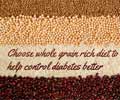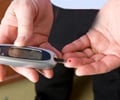Replacing saturated fats with carbohydrate and mono-unsaturated fatty acids may prove beneficial for people with diabetes.
According to a Florida study published in the Nutrition Journal, macronutrients may play a key role in arterial health for individuals with diabetes; thus, modifying the diet for macronutrient balance may prevent associated diseases.Diabetes is a global epidemic. Cardiovascular disease (CVD), especially heart disease and stroke, is the most prevalent complication of diabetes. It is known that arterial stiffening leads to CVD in diabetic people. This stiffening of the artery, due to high blood pressure (hypertension) or fatty deposits on the walls of the arteries (atherosclerosis), causes elevated pulse pressure on the arteries known as the arterial pulse pressure (APP). APP is measured as the numeric difference between the systolic and diastolic blood pressure. For example, if your blood pressure is 120 / 80 mm Hg, then your APP is 40, which is considered a healthy pulse pressure. A high APP is indicative of increased arterial stiffness which is an indicator of CVD associated with complications of diabetes. This CVD, in turn, is associated with endothelial dysfunction.
Endothelium is the inner lining of the blood vessels (arteries). Endothelial cells control vascular relaxation and contraction as well as release of enzymes that control blood clotting and immune function. Endothelial dysfunction (when the endothelial cells are not working properly) can predict stroke and heart attacks due to the inability of the arteries to dilate fully. The dysfunction may be a result of high blood pressure, diabetes, high cholesterol and smoking. So, arterial pulse pressure (APP) may be a feasible method for screening endothelial function and arterial health of an individual.
A study was conducted by Joan A. Vaccaro and Fatma G. Huffman to assess APP and its association with macronutrient by diabetes status for a multiethnic sample involving 892 Mexican Americans, 1059 black non-Hispanics, and 2473 white non-Hispanics.
There were a number of reasons why the researchers chose to do this study.
1. Although the role of diet in the prevention of high blood pressure has been established, the role of diet on APP has not been determined.
3. Several clinical trials reported that proportion of calories from carbohydrates have an effect on high blood pressure. But few studies compare these effects for persons with type-2 diabetes.
The results of the current study showed that –
* Lower intake of carbohydrates and mono-unsaturated fatty acids (MUFA) were associated with higher arterial pulse pressure (APP) for diabetic people as compared with persons without diabetes, independent of ethnicity.
* Poly-unsaturated fatty acids were not associated with APP.
* Endothelial function in diabetic individuals was not significantly altered by a MUFA-rich meal but it was impaired by a meal high in saturated fatty acids. This means that MUFA, in the form of olive oil, may have a protective effect on endothelial function in people with type-2 diabetes. Olive oil contains many polyphenols in different amounts and types and these polyphenols may play a role in enhancing endothelial function by promoting the formation of nitric oxide.
The study thus concluded that lower arterial pulse pressure can be attained by replacing saturated fats with carbohydrates and mono-unsaturated fatty acids (MUFA) in people with diabetes.
The study however had its limitations, in the sense
* Diabetes diagnosis was by self-report and not by medical records. The American Diabetes Society and the World Health Organization, however, endorse the determination of self-reported diabetes.
* The data did not include ethnic groups such as Asians and Hispanics other than Mexican Americans.
* The sources of MUFA were not quantified in this study, so the variations in anti-oxidant properties may have influenced the association of MUFA with arterial pulse pressure.
The researchers suggest further intervention and prospective studies to confirm the associations of arterial pulse pressure (APP) with diabetes, race and diet.
Reference:
Vaccaro JA, Huffman FG. Monounsaturated fatty acid, carbohydrate intake, and diabetes status are associated with arterial pulse pressure. Nutr J. 2011 Nov 16;10(1):126.
Source-Medindia















